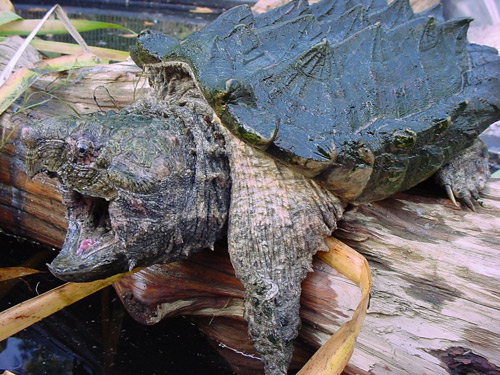Information on the alligator snapping turtle.
Although the resemblance between common snapping turtles (Chelydra serpentine) and alligator snapping turtles (Macrochelys temminckii) is obvious, they are actually rather distant cousins, and there are some very distinct differences as well.
The natural range of the alligator snapper is restricted to river systems that drain into the Gulf of Mexico along its northern coast, from central Florida westward to eastern Texas, extending north as far as southern Iowa in the Mississippi River basin. They prefer deeper, moving water, but they can occasionally be found in oxbow lakes and other waterways adjoining rivers.

The average length of an adult alligator snapping turtle (Macrochelys temminckii) is 24 inches
The shell of hatchling alligator snappers exhibit rugosity similar to common snappers, but the “smoothing out” process is much more protracted, and three keels are present throughout their lives, even into advanced age. A row of supramarginal scutes extends along each side of the carapace, just above the bridge, and a row of inframarginals is arranged between the bridge and ventral marginals. Among all North American species of freshwater turtle, this scute arrangement is unique to alligator snappers. The neck is quite short by snapping turtle standards, but the head of the alligator snapping turtle is proportionately large, with massive hooked jaws. And then, of course, there is the most famous characteristic of the alligator snapping turtle: the wormlike appendage on the tip of the tongue, which the turtle can wriggle with mouth agape to lure in unsuspecting fish.
Size-wise, the alligator snapper is no slouch either. Although record lengths of over 30 inches are known (but exceptional), average lengths over 24 inches are common. They are also very long-lived, and as recently as the 1970s trappers were finding alligator snapping turtles with musket balls and flint arrowheads lodged in their shells! Given their potential to live upward of 150 years, anyone considering an alligator snapper should be prepared to keep a very large turtle for a very long time!
Alligator snappers have not been known to bask, but young turtles will sleep on partially submerged objects. So although a completely dry basking dock is not required, an adequate structure that will allow the turtle to climb from the bottom and surface must be provided. Full-spectrum or ultraviolet lighting is not necessary, but to allow adequate calcium metabolism, a varied diet including vitamin D supplementation should be provided. These days, commercial pellet turtle foods have adequate vitamin D, which is convenient given that powdered supplements wash off food when it’s placed in the water.
Alligator snappers are more carnivorous than common snappers, but they will consume limited amounts of certain vegetation. They actively forage for food and eat a wide variety of animal matter. Crickets, mealworms, crayfish, earthworms and feeder fish are all taken with enthusiasm. The added bonus for providing feeder fish is that the turtle may display its lure when attempting to devour the feeder fish. Grapes are eagerly eaten, and leafy greens are occasionally accepted, as well. Although many hatchling alligator snapper will initially ignore pellet food, most can be weaned over to feeding on pellets by the time they are juveniles.


